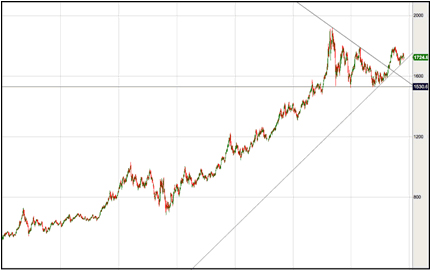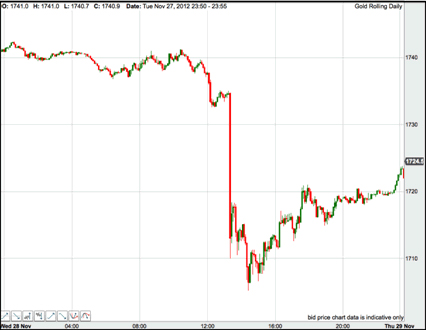It’s all very well being contrarian, but being bearish on gold is equivalent to walking down the High St with a sandwich board saying “The end is nigh …”. Of course, you could be right, but there’s glaring evidence to suggest that the sun will rise again tomorrow.
Sure, gold has wobbled in the last 12 months or so, but, as you can see in this long-term chart, it’s broken through the consolidation triangle that formed, and is continuing its relentless upwards slog.

However, anyone who was long gold on Wednesday, who saw the metal drop nearly $25 in the space of 5 minutes, will be feeling decidedly negative about gold. Trading at just £10 a point, that’ll be a cool £2,500 wiped out in 5 minutes.

There are a number of reasons cited for this fall in gold – like the positive data from the US and the expiration of options and futures contracts. And, these kinds of moves really aren’t that unusual in gold.
Which is why gold traders usually need to have seriously deep pockets – deep enough to place their stops very wide, so that they aren’t knocked out by a $20 swing that would make most of our eyes water.
Traders have an uneasy relationship with volatility – we love it for the market moves it gives us, yet we hate it when those same moves mean that we get kicked out of trades.
Over recent months, many have been complaining about the “wrong sort” of volatility. Exactly what that means is difficult to pin down, but the gist is that the volatility we’re experiencing in the markets at the moment are trends that quickly reverse, causing painful losses rather than riding us into profit.
It’s exactly these kinds of markets where stop losses become very difficult to place, so I’m going to look at a few solutions …
Doing away with stops
There are a couple ways in which traders can avoid using stop losses altogether. The first is through hedging, which is a subject I’ll cover in detail at a later date. The one I want to look at today is, I believe, the simplest and the safest … binary bets.
If you downloaded the free guide to binary betting last week, or if you’ve already had a head-start on Neil Leitch’s binary options system – then you’ll know what I’m talking about.
The beauty of binary bets is that you don’t need to use stop losses. You’re placing a bet on an outcome. If the market crashes in the meantime, but still bounces back to your predicted outcome – it really doesn’t affect your bet. You can still win, and there’s no risk of getting stopped out.
Sure, your trade might lose – nothing is certain in this game. But there isn’t the risk of that frustrating outcome when your trade gets stopped out, only for the market to return in your favour.
I’m sure that’s a feeling we can all identify with!
Now, I know that I’ve been banging on about Neil’s new system for weeks now, but I will finally be producing my full review on it next week. So do watch out for the low-down on this service.
And for traditional spread betting?
If you’re not using binary options to protect yourself from the “wrong sort” of volatility, what can you do to make your stop losses safer?
The first question to ask your self is: Are my stop losses too tight?
This isn’t an easy one to answer, as it will depend on your trading strategy – are you looking to take frequent small losses? Or do you prefer to take the occasional big loss?
But if the decision is to widen your stop, you’ll need to adjust your stakes accordingly so that you’re not increasing your risk.
The result of this could lead to reduced profitability over the long term – but if it makes your trading less stressful, and gives you a better night’s sleep, in my opinion, it’s worth the cost.
The next question is: Are my stops smart enough?
This is about looking to the left of your screen for areas of support or resistance – these are the best clues there are about where the market will turn or consolidate in the future.
Wherever possible, your stop losses should be beyond these key levels, so they don’t get caught up in the messy congestion that happens at these levels.
Stops by their very nature are vulnerable to getting hit. But by placing our stop levels wisely, we can use them as a sensible exit strategy, rather than a trading version of pulling the emergency cord! And, if you’d like to try a technique that can free you up from stop losses – please watch out for my full report on Neil’s binaries strategy next week.
In the next seven days …
With the start of a new month, next week kicks off with swathes of PMI data from around the world, and culminates with the US non-farm payroll figures on Friday afternoon.
Sandwiched between these, we have revised GDP figures for the Eurozone on Thursday, along with the ECB monetary policy meeting on the same day. This, along with the PMIs are likely to confirm a drop off in economic activity.
The main news for the UK is the Chancellor’s autumn statement on Wednesday. George Osborne is expected to announce lower GDP growth forecasts for 2012 and 2013, with higher borrowing as a result. There’s unlikely to be any surprises for the markets here.
In the US, we have construction spending, vehicle sales, and factory orders (and the non-farms on Friday, of course). There’s likely to be a fair about of upbeat data here, which seems to be distracting the markets from the “fiscal cliff” they are hurtling towards. At the moment, the mood in the markets is cautiously bullish, with positive US data fueling the confidence levels. However, any glitches in the data next week are likely to see flurries of selling – exactly that “wrong kind” of volatility that’s becoming the new norm.
